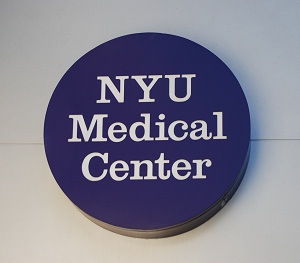2018 School Spending Survey Report
NYU Medical Library Recovering from Superstorm Sandy
Weeks after Hurricane Sandy battered New York City, progress continues on the cleanup of New York University’s flood-damaged Frederick L. Ehrman Medical Library. The Ehrman facility, the main library of NYU’s Langone Medical Center, hasn’t opened its doors since Sandy made landfall.

NYU Medical Center by Joe Shlabotnik
http://www.flickr.com/photos/joeshlabotnik/3312638702/
Attribution-NonCommercial License
UNDERGROUND WEATHER
But while things may be moving faster elsewhere, conservators and staff remain barred from the once-submerged basement level, where there’s been no chance to get a firsthand look at the materials and facilities almost certainly lost to the natural disaster. “We’re anxiously waiting for access,” said Laura McCann, a conservation librarian at NYU who has worked extensively on the Ehrman cleanup, “but we don’t know when and if that’s going to happen.” Staff must wait until health officials can be sure it’s not a hazardous area; publicly, at least, there is no timetable, and on Tuesday, Dec. 4, industrial hygienists were still conducting tests on the space McCann said. The Ehrman Library has three levels. The upper floor, the only one above street level, housed most of the archival material (including a rare book room) and “was not impacted at all” when Sandy struck, McCann told LJ. The bottom two floors were not as lucky. The ground floor took on about 18 inches of water, McCann said, which quickly receded once Sandy moved west and river tides reverted back to normal. Collections and material, kept on carts and shelves, were elevated sufficiently to stay dry. The so-called “cellar level,” one story below ground, was hit hardest. “That was completely submerged,” she said. The water has long since been pumped out, but that did not make it habitable for staff—or for physical collections. Belfor was able to help save some valuable items from among the books, papers, and archives that were submerged, including a trove of roughly 300 19th-century medical pamphlets—a “very important collection,” according to McCann. The first step, she said, was to freeze the waterlogged pamphlets, in small bunches of four to seven, in order to later facilitate the drying-out process. However, Rambo said an 11,000-volume collection stored in the cellar level has been written off. “We’re assuming that’s a loss,” he said. “Of course I wish we could get down there,” McCann said, “but I don’t feel surprised. This is how I know it can go.” As a conservation librarian, McCann has received specialized training in helping deal with the effects of natural disasters on facilities, training which has proven remarkably useful now. “This is very typical,” she added. “This is exactly what they told us happens.” Rambo declined to put any dollar figure on the cost of the Ehrman Library cleanup. He cited any estimate as premature, particularly since work has barely started on the bottom level. In the meantime, there is planning to do in preparation for the days when conservators can have a look at the closed-off areas. Said McCann, “Where are my collections? Where are my priorities? What are the risks? And how do we mitigate those risks? We’re going through that process right now.”NOT PLAYING THE BLAME GAME
None of the NYU officials interviewed said recriminations or second-guessing has been a focus, particularly since almost everyone underestimated Sandy’s impact on New York’s rivers and infrastructure. Ehrman Library is located in the city’s Flood Zone A, which is considered in danger of flood damage from any hurricane, no matter what the strength. But the scope of the flooding took almost everyone by surprise. NYU officials, however, challenge any assertion they were unprepared for Sandy’s arrival or overconfident their facilities would be impervious to the storm’s effect on Manhattan. Indeed, in the aftermath, city officials said Sandy’s damage was indicative of a much-larger storm, evidenced by its devastating effect on areas and infrastructure (such as subways) not deemed at risk as the system approached from the south. Some 14 months before Sandy, the Ehrman Library took no damage from Hurricane Irene, another massive storm that aimed its fury mainly at New York and New Jersey. “It was completely unscathed,” Rambo said of that storm’s effort on NYU’s medical library. “This (the storm surge) had just never happened before.” “In terms of relocating collections, we didn’t do a lot of that in preparation for Sandy,” he added. “We didn’t know. This didn’t look like it was going to be any more than was sustained before.” Of course, when the facility is rebuilt, NYU officials will no longer have the luxury of assuming the worst can’t happen. Said McCann, “You have to think, ‘What about that 100-year storm?’ Because it just might come.”RELATED
RECOMMENDED
TECHNOLOGY
ALREADY A SUBSCRIBER? LOG IN
We are currently offering this content for free. Sign up now to activate your personal profile, where you can save articles for future viewing









Add Comment :-
Comment Policy:
Comment should not be empty !!!
elizabeth mcmahon
Meanwhile, is anybody aware that 10,000 lab animals were abandoned and left to drown in basement NYU medical labs? I highly recommend reading this letter and recriminate and second guess and point the finger at the guilty parties who allowed this abject, avoidable catastrophe to occur. For more information on this underreported, infuriating occurrence, please see: http://www.pcrm.org/media/blog/nov2012/hurricane-sandy-10000-animals-die-in-nyu-labPosted : Dec 07, 2012 04:22